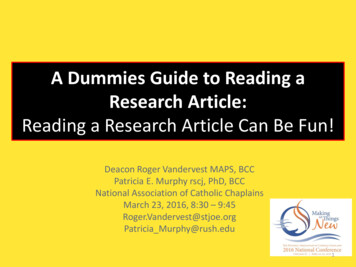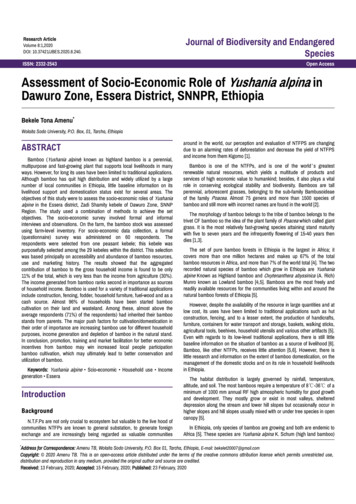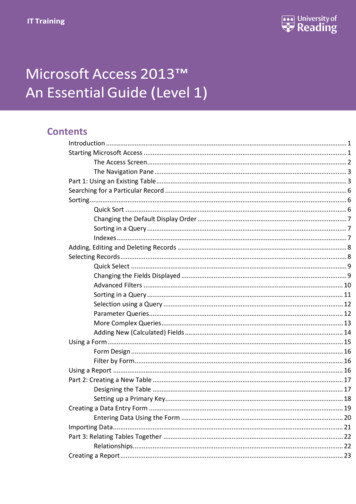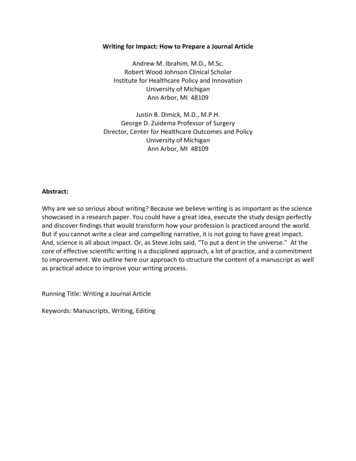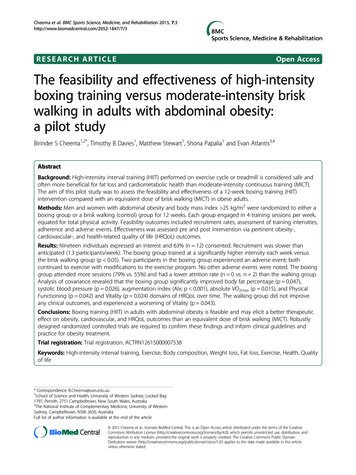
Transcription
Cheema et al. BMC Sports Science, Medicine, and Rehabilitation 2015, RCH ARTICLEOpen AccessThe feasibility and effectiveness of high-intensityboxing training versus moderate-intensity briskwalking in adults with abdominal obesity:a pilot studyBirinder S Cheema1,2*, Timothy B Davies1, Matthew Stewart1, Shona Papalia1 and Evan Atlantis3,4AbstractBackground: High-intensity interval training (HIIT) performed on exercise cycle or treadmill is considered safe andoften more beneficial for fat loss and cardiometabolic health than moderate-intensity continuous training (MICT).The aim of this pilot study was to assess the feasibility and effectiveness of a 12-week boxing training (HIIT)intervention compared with an equivalent dose of brisk walking (MICT) in obese adults.Methods: Men and women with abdominal obesity and body mass index 25 kg/m2 were randomized to either aboxing group or a brisk walking (control) group for 12 weeks. Each group engaged in 4 training sessions per week,equated for total physical activity. Feasibility outcomes included recruitment rates, assessment of training intensities,adherence and adverse events. Effectiveness was assessed pre and post intervention via pertinent obesity-,cardiovascular-, and health-related quality of life (HRQoL) outcomes.Results: Nineteen individuals expressed an interest and 63% (n 12) consented. Recruitment was slower thananticipated (1.3 participants/week). The boxing group trained at a significantly higher intensity each week versusthe brisk walking group (p 0.05). Two participants in the boxing group experienced an adverse event; bothcontinued to exercise with modifications to the exercise program. No other adverse events were noted. The boxinggroup attended more sessions (79% vs. 55%) and had a lower attrition rate (n 0 vs. n 2) than the walking group.Analysis of covariance revealed that the boxing group significantly improved body fat percentage (p 0.047),systolic blood pressure (p 0.026), augmentation index (AIx; p 0.001), absolute VO2max (p 0.015), and PhysicalFunctioning (p 0.042) and Vitality (p 0.024) domains of HRQoL over time. The walking group did not improveany clinical outcomes, and experienced a worsening of Vitality (p 0.043).Conclusions: Boxing training (HIIT) in adults with abdominal obesity is feasible and may elicit a better therapeuticeffect on obesity, cardiovascular, and HRQoL outcomes than an equivalent dose of brisk walking (MICT). Robustlydesigned randomized controlled trials are required to confirm these findings and inform clinical guidelines andpractice for obesity treatment.Trial registration: Trial registration: ACTRN12615000007538Keywords: High-intensity interval training, Exercise, Body composition, Weight loss, Fat loss, Exercise, Health, Qualityof life* Correspondence: B.Cheema@uws.edu.au1School of Science and Health, University of Western Sydney, Locked Bag1797, Penrith, 2751 Campbelltown, New South Wales, Australia2The National Institute of Complementary Medicine, University of WesternSydney, Campbelltown, NSW 2650, AustraliaFull list of author information is available at the end of the article 2015 Cheema et al.; licensee BioMed Central. This is an Open Access article distributed under the terms of the CreativeCommons Attribution License (http://creativecommons.org/licenses/by/4.0), which permits unrestricted use, distribution, andreproduction in any medium, provided the original work is properly credited. The Creative Commons Public DomainDedication waiver ) applies to the data made available in this article,unless otherwise stated.
Cheema et al. BMC Sports Science, Medicine, and Rehabilitation 2015, roundObesity is a major risk factor for many chronic noncommunicable diseases, and the prevalence of this condition in the global population has doubled since 1980[1]. Recent data suggest that approximately 36.9% ofmen and 29.8% of women worldwide are categoricallyobese [2]. The high and rising prevalence of obesity isassociated with increased rates of cardiovascular diseases, cancers [3], type 2 diabetes and chronic kidneydisease [1], placing tremendous strain on healthcare systems and national economies [4]. Individuals with obesity also suffer from low health-related quality of life(HRQoL) [5] and increased mortality [6] versus theirhealthy peers. Innovative and efficient strategies fortreating excess body fat are still needed, and could resultin significant health and economic benefits.Current physical activity guidelines [7,8] recommend150 to 250 minutes per week of moderate-intensitycontinuous training (MICT) such as brisk walking totarget overweight/obesity and maintain an optimal bodyweight. These physical activity guidelines are similar tothose recommended by the World Health Organizationfor general health [9]. However, randomized controlledtrials (RCT) suggest that brisk walking interventions( 12 weeks) elicit only a small beneficial effect on bodyweight and adiposity outcomes in overweight and obeseadults [10-12]. Hence, this modality of exercise, despitebeing recommended [7,8], may not be particularly effectivefor inducing clinically meaningful reductions in body fat.High-intensity interval training (HIIT) involves alternating brief (6 s-4 min) high intensity ( 75% VO2max)and lower intensity workloads or rest throughout an exercise session. This shorter duration of exercise may bea more efficient alternative for eliciting fat loss thanMICT. Studies in patients with cardiac and metabolicdiseases [13-17] have consistently shown that HIIT( 12 weeks) performed on a cycle or treadmill ergometeris safe, and can result in greater improvements of cardiorespiratory fitness (VO2max), endothelial function (i.e.atherosclerosis), insulin signalling and left ventricularmorphology and function versus MICT matched fortraining load or volume (frequency/duration). Studieshave also shown that HIIT can significantly increaseHRQoL [13,18]. There is preliminary evidence suggesting that HIIT can elicit significantly greater reductionsof adiposity than MICT in overweight and obese cohorts[19-21]. However, this evidence is less consistent andindicates a need for further research.Boxing training typically involves high intensity intervals of 2 to 3 minutes combined with shorter intervals ofrest. Therefore, boxing training is recognized as a metabolically demanding mode of HIIT [22]. Despite itspopularity in practice, no study to date has investigatedthe use of boxing training as a mode of HIIT for thePage 2 of 10management of obesity and related health outcomes.Therefore, the aim of this pilot study was to assess thefeasibility and effectiveness of a 12-week boxing training(HIIT) intervention compared with an equivalent doseof brisk walking (MICT) in adults with abdominal obesity. Feasibility outcomes included recruitment rates, assessment of training intensities, adherence and adverseevents, and effectiveness was assessed pre and postintervention via pertinent obesity, cardiovascular, andHRQoL outcomes.MethodsStudy designA parallel group design that randomized participants toa boxing group or brisk walking (control) group was utilized. Outcome measures were assessed prior to and following a 12-week intervention period. Post interventiontesting was completed 72 hr after the final exercise session. A blinded assessor with International Society forthe Advancement of Kinanthropometry (ISAK) accreditation collected all anthropometric (obesity) data. Randomization assignments were computer-generated (www.randomization.com) and stratified by gender, by an investigator not involved in data collection; assignments weregiven to participants in sealed envelopes upon the completion of baseline testing. The University of WesternSydney Human Research Ethics Committee approved allprocedures, and informed consent was received from allparticipants.ParticipantsParticipants were recruited over a nine-week periodfrom June 3 to August 2, 2013 by means of flyer advertisements, university staff email lists and social media(Facebook). The aim was to recruit two participants perweek, on average. Eligibility criteria: adult ( 18 years);body mass index (BMI) 25 kg/m2; abdominal obesity asa risk factor for cardiometabolic disease according to theInternational Diabetes Federation (i.e. waist circumference 94 cm in men and 80 cm in women) [23]; available to complete four exercise sessions per week; able tocommunicate in English; willingness and cognitive abilityto provide written informed consent. Exclusion criteria:physically active (i.e. engaging in greater than 3 sessionsof moderate-intensity exercise per week); current orhistory of ischaemic heart disease, cerebrovascular disease, type 2 diabetes mellitus, advanced metabolic disease(e.g. chronic kidney disease) or uncontrolled pulmonarydisease.InterventionsBoxingParticipants in the boxing group were prescribed four,50-min sessions of supervised boxing training per week.
Cheema et al. BMC Sports Science, Medicine, and Rehabilitation 2015, 7:3http://www.biomedcentral.com/2052-1847/7/3A boxing instructor assisted in designing the program.All sessions were fully supervised by qualified personnel.The interval-based exercises were preceded by a 5 minwarm-up of continuous skipping at a self-selected intensity. Intervals were prescribed at 2:1 (i.e. 2 min of highintensity activity followed by 1 min of rest (standing orpacing) between intervals and exercises). Three intervalsof each of the following five exercises were performedfor a total of 30 min of high-intensity effort: (1) heavybag, (2) focus mitts, (3) circular body bag, (4) footworkdrills, and (4) skipping. The total amount of physical activity (excluding warm up and rest periods) was computed as 30 min 6 metabolic equivalents (MET) perminute 180 MET min [24]. During the high-intensitybouts, participants were instructed to exercise at a ratingof perceived exertion of 15-17/20 (“hard” to “very hard”)with the goal of achieving 75% of age-predicted maximal heart rate (i.e. 220-age; HRmax).Page 3 of 10Clinical outcome measuresObesity outcomesWaist circumference was measured in a horizontalplane, midway between the inferior margin of the ribsand the superior border of the iliac crest, according tostandard protocol [25]. Height and weight were measured with calibrated scale (A&D Company Ltd.,Japan) and stadiometer (Holtain Ltd., Crymych, UK),respectively, and BMI was computed from these measures [25]. Six skinfold sites (i.e. triceps, subscapular,supraspinale, abdominal, front thigh and medial calf )were recorded using Holtain callipers (Holtain Ltd.,Crymych, UK) if the skinfold was 40 mm and Slimguide callipers (Creative Health Products, Plymouth,USA) if the skinfold was 40 mm. Body fat percentagewas computed from the six skinfold sites using validated equations [26].Cardiovascular outcomesTraining intensity Heart rate was monitored using aPolar Heart Rate monitor (Polar RS800sd Kempele,Finland) and was recorded at the completion of eachhigh-intensity interval; these values were averaged acrosseach week, and reported as percentage of age-predictedHRmax.WalkingParticipants in the walking group were prescribed four,50-min sessions of brisk walking per week. These sessions were unsupervised and completed in any locationconvenient to the participant (e.g. within their ownneighbourhood, etc.). Participants were instructed tobegin each session with a 5-min gradual warm-up andwalk as quickly as possible for the remainder of the session(45 min). The total amount of physical activity (excludingwarm up) was computed as 45 min 4 metabolic equivalents (MET) per minute 180 MET-min [24].Training intensity Participants were taught how tomanually monitor their heart rate and record the measure pre-, mid- and post-exercise. These data wererecorded in a training journal. The mid-exercise readingswere averaged across each week, and reported as percentage of age-predicted HRmax.Adherence and adverse eventsAdherence was defined as the number of training sessions attempted divided by the number offered multiplied by 100%. Adverse events were documented bymeans of a structured, open-ended questions administered weekly, in person or via telephone or email.Resting blood pressure (systolic/diastolic) and heart ratewere assessed manually at the brachial and radial artery,respectively, with the participant in a seated positionaccording to standard protocols [27]. Arterial stiffnesswas assessed using the SphygmoCor System (AtCorMedical Pty, Sydney, Australia). This system derives thecentral aortic pressure waveform noninvasively from thepulse pressure recorded at a peripheral site. Participantswere seated for a 10-min period, then radial pulse pressurewaveform recording were obtained using a hand-held,high fidelity tonometer (Millar Instruments, Houston,Texas). The aortic pressure waveforms are comprised of aforward wave caused by left ventricular contraction and areflected wave due to backflow arising from regions ofincreased impedance in the peripheral vessels. The resultant of these two pressures is known as the augmentationindex (AIx) which was recorded. The SphygmoCor algorithm normalises AIx to a heart rate of 75 beats per minute. This method is highly reproducible [28] and hasbeen used extensively to evaluate arterial stiffness inhealthy [29,30] and chronically diseased cohorts [31].Population norms for AIx range from 23.27% to 63.07%in adults (aged 18–86 years) with larger values indicatinggreater arterial stiffness [32].Cardiorespiratory fitness (VO2max) was assessed via indirect calorimetry (Jaeger Metabolic Gas Analysers,Viasys Healthcare, Germany) using a standard rampprotocol on a laboratory treadmill (LE 200 CE, ViasysHealth Care, USA). O2 and CO2 sensors were calibratedprior to each test using high-grade calibration gas withcertified gas concentrations (O2 16%, CO2 5%, N2 balance). The protocol began at a pre-determined, comfortable walking speed for 3 minutes; the grade wasincreased by 2% each minute thereafter until volitionalfatigue.
Cheema et al. BMC Sports Science, Medicine, and Rehabilitation 2015, 7:3http://www.biomedcentral.com/2052-1847/7/3HRQoL outcomesThe Medical Outcomes Trust Short Form-36 Health Survey (Version 1.0) (SF-36) [33] was used to evaluate Physical Functioning, General Health and Vitality domains ofHRQoL. Higher scores, ranging from 0–100, denotehigher HRQoL.Page 4 of 10studies. Effect sizes were interpreted according to the conventions of small (0.20), moderate (0.50), or large (0.80). Ap value of 0.05 was considered indicative of statisticalsignificance.ResultsStatistical analysesRecruitment and flow of participantsAnalyses were performed using the Statistical Packagefor the Social Sciences (IBM , SPSS Version 19.0). Alldata were inspected visually and statistically for normality(skewness and kurtosis between 1 and 1). Analyses werecompleted according to intention-to-treat strategy, usingthe last-observation-carry-forward imputation method forany missing data. Within group changes over time wereevaluated by paired t-tests. Group x time effects weredetermined by analysis of covariance (ANCOVA) of thepost-treatment score controlling for the baseline scoreand potential confounding variables identified by comparing groups at baseline. Cohen’s d effect sizes were calculated to explore the effectiveness of the intervention andprovide data to inform sample size calculations in futureNineteen individuals (n 19) expressed an interest inthe study and five individuals were deemed ineligibledue to a medical condition, or not meeting the waist circumference or physical activity criteria (Figure 1). Fourteen individuals were deemed eligible, however twoelected not to participate due to inconvenience. Twelveindividuals provided written informed consent, completed baseline testing and were randomized into theboxing training (n 6) or walking (n 6) groups. Recruitment rate was slower than expected (12 participants/9 weeks of recruitment 1.3 participants recruitedper week). Two female participants in the walking groupwithdrew: one due to a pre-existing knee injury requiringsurgery (week 2) and one for personal reasons (week 5).Figure 1 Flow of participants through the trial. *Baseline data carried forward for 2 participants lost to follow-up.
Cheema et al. BMC Sports Science, Medicine, and Rehabilitation 2015, ine data were carried forward for both participantsfor analyses (intention-to-treat).Page 5 of 10rowing for skipping while his calf muscle recovered. Neither participant missed a training session due to their injury. No additional adverse events were noted.Baseline characteristicsNo statistically significant differences were noted betweengroups at baseline (Table 1). However, due to clinically important differences in age and waist circumference, thesevariables were included as covariates in all ANCOVAmodels. The cohort ranged in age from 19 to 72 years,BMI ranged from 26.4 to 40.3 kg/m2 and all participantsfulfilled the criterion for abdominal obesity [23]. Commoncomorbidities included hypertension (n 3) and asthma(n 2).Training intensityMean training heart rate during the 12-week interventionperiod ranged from 86-89% and 64-77% of age-predictedHRmax in the boxing and walking groups, respectively(Figure 2). The boxing group trained at a significantlyhigher intensity versus the walking group in each week(p 0.05).Adherence and adverse eventsAdherence to training was 79 15% and 55 43% in theboxing and walking groups, respectively, inclusive of thetwo participants in the walking group who withdrew(Figure 1). Excluding these participants, attendance inthe walking group was 82 12%. The difference in attendance between groups was not significant inclusive(p 0.24) or exclusive (p 0.75) of the two participantswho dropped out. Five participants in the boxing groupand 3 participants in walking group attended more than70% of their prescribed exercise sessions.A female participant in the boxing group experiencedtennis elbow in week 1 that may have been due to theintervention. She remained in the study by substitutingkicking and elbow striking in place of punching. A maleparticipant in the boxing group experienced a strain ofthe gastrocnemius muscle in week 8, which may havebeen induced by skipping. The participant substitutedTable 1 Baseline characteristics of the total cohort andgroupsCharacteristicAge (y)Women:MenTotal cohort(n 12)Boxing(n 6)Walking(n 6)39 (17)43 (19)36 (15)7:53:34:2Body weight (kg)90.7 (16.3)95.7 (21.0)85.6 (9.1)Height (cm)169.6 (8.2)172.3 (7.7)166.8 (8.4)BMI (kg/m2)31.4 (4.4)32.0 (5.9)30.8 (2.6)Waist circumference (cm)104.7 (14.4)111.0 (18.0)98.4 (6.2)Body fat percentage (%)35.4 (11.3)33.5 (10.1)37.3 (13.1)Data continuous variables reported as mean (standard deviations).OutcomesObesity outcomesWithin and between group analyses are presented inTable 2. The boxing group reduced body fat percentageover time with a small to medium effect that reachedstatistical significance (Cohen’s d 0.41; p 0.047). Waistcircumference, body mass and BMI was also reduced inthe boxing group with small to medium effect (Cohen’sd 0.29-0.48); however, these effects did not achieve statistical significance. The walking group reduced body fatpercentage over time with a small effect (Cohen’s d 0.21; p 0.17) with no other effects noted. No group xtime interaction effects were noted for waist circumference, body mass, BMI, or body fat percentage.Cardiovascular outcomesThe boxing group reduced resting systolic- and diastolicblood pressure, heart rate, augmentation index, andpulse pressure over time with a medium to large effect(Cohen’s d 0.69-1.50); reductions in AIx (p 0.001)and systolic blood pressure (p 0.026) reached statisticalsignificance. By contrast, the walking group unexpectedly increased pulse pressure, AIx, and systolic bloodpressure over time with a small to large effect (Cohen’sd 0.33-0.93) though none of these changes reachedstatistical significance (Table 2). Small to medium group xtime interaction effects indicating positive adaptation inthe boxing group versus the walking group were noted forAIx (Cohen’s d 0.41; p 0.064) and resting systolic(Cohen’s d 0.33; p 0.10) and diastolic blood pressure(Cohen’s d 0.26; p 0.16).The boxing group improved relative- (Cohen’s d 1.28;p 0.06) and absolute VO2max (Cohen’s d 0.41; p 0.015)over time with a large and medium effect, respectively.The effect for absolute VO2max was statistically significant.The control group did not improve these measures overtime. No group x time interaction effects were noted forVO2max measures.HRQoL outcomesThe boxing group improved Physical Functioning (Cohen’sd 0.98; p 0.042), General Health (Cohen’s d 1.45; p 0.07) and Vitality (Cohen’s d 0.74; p 0.024) domains ofHRQoL over time with large effects. The effects for Physical Functioning and Vitality were significant. By contrast,the walking group significantly reduced Vitality over timewith a moderate effect (Cohen’s d 0.30; p 0.043) anddid not experience a change in the other two domains.Small to moderate group x time interaction effects favouring the boxing group were noted each of these HRQoL
Cheema et al. BMC Sports Science, Medicine, and Rehabilitation 2015, 7:3http://www.biomedcentral.com/2052-1847/7/3Page 6 of 10Figure 2 Mean training heart rate in the boxing and walking groups. *Significant difference versus the walking group.domains (Cohen’s d 0.22-0.54) with the effect for Vitalityreaching statistical significance (p 0.02).Sensitivity and post hoc analysesGroup x time sensitivity analyses were performed without imputation of missing data from the two participantsin the walking group who withdrew and did not undergofinal assessment. The outcomes of these analyses did notdiffer with primary analyses except that AIx was significantly improved in the boxing group versus the walkinggroup over time (Cohen’s d 0.58; p 0.046).To determine the effect of higher adherence on treatment effects, group x time post hoc analyses were performed using data from participants who completed 70% of the boxing (n 5) or walking (n 3) intervention. The outcomes of these analyses did not differ withthe primary analyses.DiscussionThis is the first pilot study to assess the feasibility andeffectiveness of a 12-week boxing training (HIIT) intervention compared with an equivalent dose of brisk walking (MICT) in 12 obese adults. Our recruitment ratewas slower than anticipated. There is some evidence tosuggest that boxing might be perceived as a high-riskactivity [34], and methods to facilitate recruitment andretention, perhaps involving appropriate survey instruments[35] should be considered in the development of futuretrials. No serious adverse events were noted and the boxing group attended more exercise sessions and had a lowerattrition rate than the walking group, suggesting that thisform of HIIT may be feasible to administer in this cohort.Limitations of this pilot study included the small samplesize (n 12), lack of a non-exercising control group, thelack of direct supervision of the walking group, and thelack of monitoring of dietary and physical activity changes,which are key confounding variables. These limitationsmust be considered in the development of future RCT.Obesity outcomesThe boxing group significantly reduced body fat percentage( 13.2%; p 0.047) and experienced a small-to-moderate(non-significant) reduction of waist circumference ( 5.3%)body mass ( 4.1%) and BMI ( 4.0%) over time. Collectively, these adaptations indicate reduced body adiposity,which is associated with a reduced risk of chronic diseases(i.e. insulin resistance, type 2 diabetes, cancers, and cardiovascular diseases) and associated mortality [36-38]. It isdifficult to quantify the clinical significance of thesechanges given our small sample size and pooling of datafor men and women. Stevens et al. [39] suggest that 5%weight loss is clinically meaningful. The boxing groupapproached this level of change ( 4.1%) while no changewas noted in the walking group ( 0.3%). A longer training
Outcome measuresBoxing (n 6)Walking (n 6)P(betweengroups)Effect size(betweengroups)Week 0Week 16%ChangePEffect size(within group)Week 0Week 16%ChangePEffect size(within group)Waist circumference (cm)111.1 (18.0)104.4 (12.2) 5.3 (7.7)0.190.4898.4 (6.2)97.8 (6.7) 0.6 (2.7)0.610.100.860.004Body mass (kg)95.7 (21.0)90.8 (15.1) 4.1 (7.0)0.230.2985.6 (9.1)85.4 (9.4) 0.3 (1.2)0.630.020.930.001Obesity outcomes:BMI (kg/m )32.0 (5.9)30.5 (4.0) 4.0 (7.3)0.250.3330.8 (2.6)30.7 (3.0) 0.3 (1.8)0.780.0310Body fat percentage (%)33.5 (10.1)29.5 (11.1) 13.2 (10.6)0.0470.4137.3 (13.1)35.0 (11.3) 5.4 (7.5)0.170.210.950.00466 (4)62 (6) 6 (8)0.100.8675 (12)74 (11) 1 (4)0.430.090.340.13Resting SBP (mmHg)137 (12)123 (8) 10 (7)0.0261.50127 (4)129 (8) 2 (5)0.450.340.100.33Resting DBP (mmHg)89 (8)82 (9) 8 (8)0.0740.9089 (7)89 (5)0 (7)100.160.26Augmentation Index (%)17.0 (15.4)7.2 (15.7) 126.7 (128.4) 0.0010.6912.0 (18.5)16.8 (12.6) 41.4 (95.2)0.410.330.0640.41Pulse Pressure (mmHg)47 (9)41 (5) 10 (23)0.280.9038 (3)41 (4) 9 (14.0)0.220.930.360.122Cardiovascular outcomes:Resting HR (beats/min)VO2max (ml/kg min)VO2max (L/min)27.9 (2.4)32.5 (5.0) 16.9 (18.6)0.061.2829.0 (6.4)28.8 (8.0) 1.1 (16.3)0.930.030.340.132.691 (0.688)2.970 (0.802) 10.2 (6.7)0.0150.412.490 (0.691)2.454 (0.761) 1.6 (16.5)0.780.050.220.2192.5 (6.1)96.7 (2.6) 4.7 (4.4)0.0420.9891.7 (11.7)90.8 (8.0) 0.12 (9.3)0.810.100.110.32Cheema et al. BMC Sports Science, Medicine, and Rehabilitation 2015, 7:3http://www.biomedcentral.com/2052-1847/7/3Table 2 Summary of within and between group changes on clinical outcomesHRQoL outcomes:Physical FunctioningGeneral Health53.3 (8.8)65.0 (8.9) 25.2 (32.1)0.071.4565.8 (20.1)62.5 (25.1) 7.3 (16.8)0.440.150.210.22Vitality50.0 (28.5)66.3 (191) 54.8 (49.9)0.0240.7468.8 (32.6)59.7 (33.8) 19.1 (28.3)0.0430.300.020.54Data expressed as mean (standard deviation). Abbreviations: BMI body mass index, HR heart rate, SBP systolic blood pressure, VO2peak peak oxygen consumption. Effect size Cohen’s d.Page 7 of 10
Cheema et al. BMC Sports Science, Medicine, and Rehabilitation 2015, ion ( 12 weeks) or more frequent training ( 4 sessions/wk) may have induced more favourable adaptationof obesity outcomes.Studies in overweight and obese participants have consistently shown that HIIT performed on treadmill orcycle ergometer (12–26 weeks) can reduce BMI, waistcircumference, body weight and body fat percentageversus a no-exercise control [17]. However, the effect ofHIIT versus MICT on adiposity outcomes remainsequivocal with many studies demonstrating an equivalent effect [17,40] and other studies showing a superior[19,20] or inferior effect [41] of HIIT. These inconsistentdata may be due to the heterogeneity of HIIT interventions (e.g. intervals have ranged from 6 s to 4 min [21]),cohorts (e.g. age, level of obesity), and methods use toequate the HIIT and MICT prescriptions across studies.Further research is therefore warranted [21]. No significant group x time interaction effects were noted forobesity outcomes in the present study. However, withingroup changes suggest a need for a well-powered studyof boxing training (HIIT) versus brisk walking (MICT)to explore these comparisons further. Such studiesshould also investigate the effect of various prescriptions(dosages) of HIIT on these outcomes. Based on the percentage change score data for abdominal obesity (waistcircumference) in the boxing group ( 5.3 7.7%) andwalking group ( 0.6 2.7%), we estimate that approximately 50 participants (25 per group) would provide80% power to detect a statistically significant differencebetween groups on this outcome measure.Cardiovascular outcomesThe boxing group significantly reduced resting systolicblood pressure ( 10%; p 0.026) and AIx ( 126.7%; p 0.001) and increased absolute VO2max ( 10.2%; p 0.015) while experiencing large effects (Cohen’s d 0.86)and trends toward reduced resting heart rate ( 6%; p 0.10) and diastolic blood pressure ( 8%; p 0.074) andrelative VO2max ( 16.9%; p 0.06). No adaptations werenoted in the walking group, and trends toward group xtime interaction were noted for AIx (p 0.064), and restingsystolic- (p 0.10) and diastolic blood pressure (p 0.16).Our findings suggest that the boxing interventioninduced favourable adaptations of the central and peripheral cardiovascular system. HIIT has consistently beenshown to increase VO2max more than MICT in healthyadults [42], and those with cardiometabolic diseases[14,17,43]. Increased VO2max and reduced resting heartrate can likely be attributed to a training-induced increasein stroke volume [44], which can be influenced by factorssuch as the reversal of left ventricular remodelling andincreased ejection fraction (via increased end-diastolicvolume and reduced end-systolic volume) [14]. Further,the improvement of systolic- and diastolic blood pressurePage 8 of 10and AIx in the boxing group indicates a reduction in totalperipheral resistance (i.e. reversal of atherosclerosis) whichis likely accompanied by improved endothelial function[45]. The underlying mechanism for these adaptations isthe vascular shear stress induced by higher intensity exercise [46]. Numerous studies have shown that central andperipheral adaptations to exercise in sedentary and chronically diseased cohorts are superior with HIIT (on cycle ortreadmill) as compared to MICT [13,16,18]. The changesexperienced by the boxing group in the present study maybe clinically significant, and therefore require furtherinvestigation.HR
the use of boxing training as a mode of HIIT for the management of obesity and related health outcomes. Therefore, the aim of this pilot study was to assess the feasibility and effectiveness of a 12-week boxing training (HIIT) intervention compared with an equivalent dose o




